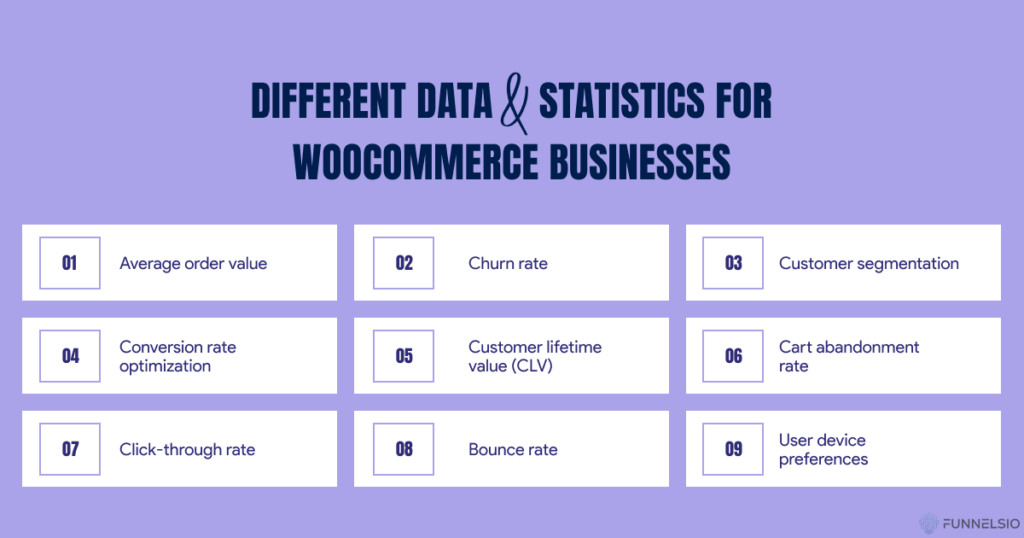Every day, there are new strategies and ideas on the internet that would advise you to optimize your WooCommerce shop. But. how would you decide if you need to optimize or change your WooCommerce shop? How to make sure you are making a positive change to your shop? Leveraging Analytics Data is the key to effective decision-making, and this blog covers how.
Data & analytics to optimize WooCommerce strategy
Data analytics has been around for a while now and has served unique businesses in their decision-making. With WooCommerce stores, it is feasible to collect users’ data and preferences. This user data can be an asset for you to tweak your WooCommerce store in different areas.
Data-driven decision-making starts by identifying the root challenges that you must address. It can help you understand the weak points of your WooCommerce user experience through actual statistics and can help you understand where you would need to improvise. Whether you need to engage users further or win them through a better offer, you can rely on gamification strategies to work on them.

Different data & statistics for WooCommerce businesses
WooCommerce shop data represents user experience and purchase patterns accurately. These statistics highlight key drivers of WooCommerce revenue and demonstrate its strengths and weaknesses. Some of the key statistics you need to keep track of are:
Average order value
The average value of an order from customers represents how much an average user is buying from the WooCommerce store at a time. The average order value represents if you need to improve on upselling to your customers through further recommendations.
Churn rate
The churn rate is the measure of customers who stop their purchases with a particular product or a WooCommerce store. A higher churn rate should be a big reason to worry for a WooCommerce store, as it must rely on customer acquisition efforts.
Gamification to improve and reduce the Churn rate would be a good alternative. 5% is an acceptable churn rate for eCommerce businesses, and one must aim to maintain that ratio.
Customer segmentation
Customer segmentation refers to understanding your customers by defining their purchase patterns, demographics, searches, and their interests. It can allow you to nudge them to the right path and convert them into a sale.
Conversion rate optimization
Is your WooCommerce store able to convert a good portion of its visitors into customers? Conversion rate optimization can be the key to understanding if you need gamification to help you improve the conversation rate.
Just by tracking the conversion rate optimization, you can identify if you are able to generate more sales through your visitors. It can attest to and verify the effectiveness of gamification methods in different areas.
Customer lifetime value (CLV)
The customer lifetime value is the average amount of business a single user performs with a particular brand or business. The customer lifetime value is how you can determine if you are able to retain your customers or now. Poor customer lifetime value can help you decide if you must work on improving customer loyalty initiatives.
Cart abandonment rate
Cart abandonment is the most prominent pain point for WooCommerce sales conversions. Cart abandonment is the representation of how visitors would be interested in checking the product pricing and yet leave before making the purchase.
Gamification tools like FunnelSIO can be the game-changer as a quick, last follow-up game that provides users with a discount or a reward. This gives another opportunity to convert visitors into clients.
Click-through rate
Click-through rate is a rate to measure how many visitors click on a particular action and move forward to the next page. CTR can be the key to understanding how gamification, pop-ups, and personalized recommendations interest users to click and further interact on the website.
Higher CTR towards the purchase would mean that your WooCommerce workflows are performing well to improve sales revenue. You can experiment with checkout progress, reward games, supplementary purchase recommendations, etc., to see if users show further interest.
also read: Key Metrics to Track for Gamified WooCommerce Shops
Bounce rate
The bounce rate is where gamification becomes a game changer for your WooCommerce shop. The bounce rate is a measure of how many visitors leave your webstore without interacting with it. The lesser the bounce rate, the better customer experience a WooCommerce shop provides.
A bounce rate of 10-25% is a representation that you are not only getting visitors, but they are also engaging with your offerings. Along with gamification, you must try everything from UI/UX to interactive WooCommerce experience to improve user engagement.
User device preferences
How do you improve your webstore or gamify it if you are unaware of the user interface that your visitors interact with? That’s where you must look at statistics to see and understand how many visitors use the mobile or desktop web interface of your website.
Any ideal gamification strategy has to account for the majority of user devices and ensure that it gets the job done effectively without ruining their WooCommerce store browsing experience.

Analyze, experiment, and repeat!
WooCommerce store optimization is an ongoing process. You can always rely on reviewing the usage data and understanding some areas to work on. If the user data points in a direction to improve, one can go with a gamification strategy to improve their output.
Such a cycle of data observation and gamification can give you a competitive advantage at the end of the day and transform your WooCommerce revenue.